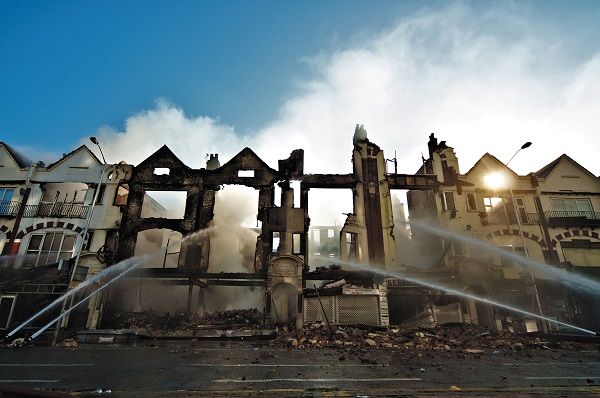Through the Roof: How Agents Can Respond to Rising Construction Costs

By: Stuart Powell
Several months ago, I had a new roof put on my house, which I paid for and did not make an insurance claim, and was shocked by the cost estimates. The roofer explained that the cost of shingles had increased substantially over the last year due to production interruptions caused by the coronavirus pandemic. A few weeks later, I was informed that the price of lumber has tripled over the past year.
Hopefully, this is a short-term situation—but it does raise a concern regarding the cost of construction compared to the property limits provided by an insurance policy. Granted, not all property losses are total losses. However, significant increases in construction material could affect a large property loss, possibly exhausting the available amounts of coverage.
What coverage options are available to mitigate rapidly increasing construction costs? Within the homeowners program, there are two options: attach one of the two additional limits endorsements or attach an inflation guard endorsement as well as one of the two additional limits endorsements.
Inflation Guard Endorsement
The inflation guard endorsement (HO 04 46) increases the initial policy limit on a pro-rata basis throughout the policy period. Unfortunately, choosing an inflation percentage is a lagging indicator and a guesstimate that may not predict the increases from an event like a pandemic interrupting the material supply chain.
Depending on the percentage chosen for the inflation guard endorsement, the additional premium can range from a 2%-6% premium increase.
Additional Limits Endorsements
There are two additional limits endorsements available. Significantly, both allow the insured to purchase an additional amount of coverage after a loss occurs. The two endorsements promulgated by Insurance Services Office (ISO) are:
- Additional Limits of Liability for Coverages A, B, C and D (HO 04 11). This endorsement allows the policyholder to purchase the necessary amount of additional limit for Coverage A to equal the property’s replacement costs after the loss. Any increase in Coverage A automatically increases Coverages B, C and D when this endorsement is attached.
- Specified Additional Amount of Insurance for Coverage A (HO 04 20). This endorsement allows the policyholder to buy additional Coverage A limits up to a specified percentage. For example if the specified limit is 25% and the Coverage A limit of insurance is $300,000, the policyholder would have up to an additional $75,000 in the event of inadequate Coverage A after a loss.
Two percentage options are available—25% and 50%—but some carriers may not allow use of the 50% option.
Of the two, the Additional Limits of Liability for Coverages A, B, C and D is the preferred option because it allows the insured to purchase whatever additional amount is necessary, and all other property coverage limits increase in relation to the new Coverage A limit. However, some homeowners insurance carriers will not use the HO 04 11, limiting the insured to only the HO 04 20.
One major advantage of both additional limits endorsements is the removal of the insurance-to-value—often referred to as the coinsurance—provision in the homeowners policy. When either of these endorsements is attached, the insured is not subject to the provision.
As expected, attaching either of these endorsements increases the premium. Use of the HO 32 11 increases the premium approximately 15% and attaching the HO 32 20 increases the premium 3%-6% depending on whether the 25% or 50% option is chosen.
A Gotcha Provision?
Both additional limits endorsements contain a key provision that agents must understand and manage. The HO 04 11 and the HO 04 20 require the insured to report even minor changes in value. The endorsements state:
To the extent that coverage is provided, we agree to amend the present limits of liability in accordance with the following provisions:
A. If you have:
2. Notified us, within 30 days of completion, of any improvements, alterations or additions to the building insured under Coverage A which increase the replacement cost of the building by 5% or more; the provisions of this endorsement will apply after a loss, provided you elect to repair or replace the damaged building.
If the insured fails to notify the insurance carrier of improvements made to the dwelling that increases its replacement cost by 5% or more, the insured loses the benefits of the endorsements. During the pandemic, home improvement and renovation activity has been unprecedented, which is a contributing factor to building material shortages and rising costs.
If an insured undertook a major kitchen renovation or addition during the policy term and if the renovation or addition increased the replacement cost—not the market value—of the dwelling more than 5%, which equates to $15,000 on a $300,000 house, the insured must notify the insurance carrier to maintain the benefits of either of the additional limits endorsements.
Insureds are often unaware of this requirement and may have neglected to tell either the agent or the carrier of any changes to their home in the past 18 months. Agents may want to consider notifying all homeowners customers that these endorsements are available and the requirements of both. Doing so protects the agent from a potential errors & omissions issue where an insured may argue that “you didn’t tell me about this.” Plus, it’s good marketing for the agency and the insured will realize their agent is looking out for them.
What About Commercial Property?
For commercial property exposures, there is no option to purchase an additional limits type of endorsement. However, blanket coverage for multiple buildings and business personal property does allow coverage to expand beyond the building limit scheduled on the Statement of Values. In theory, the entire blanket limit could be expended on one component of covered property.
While the use of the blanket option does not automatically avoid a coinsurance problem, coinsurance can be suspended by using an agreed value provision. Blanket agreed value is a favored approach to both the limits problem and the coinsurance problem.
Around 2007, insurers began attaching an endorsement that diminishes the value of blanket coverage—the Limitation on Loss Settlement-Blanket Insurance (margin clause). This endorsement limits the amount available for a building to a percentage of the amount scheduled in the Statement of Values.
For example, a building scheduled in the Statement of Values at $500,000 is damaged by a covered cause of loss and the actual replacement cost at the time of the loss is $650,000. If the damaged building is included on a policy providing a blanket limit of $1 million, then, in theory, the full $650,000 replacement cost would be recoverable. However, if the blanket policy is subject to the margin clause applying a 120% maximum limit, the recovery would be limited to $500,000 plus 20%, which only raises the limit to $600,000.
There are some proprietary versions of this type of endorsement that apply a limit per location. But be vigilant when reviewing commercial property policies written on a blanket basis. Look for endorsements that can cap the recovery for a given item in the Statement of Values.
Replacement Costs vs. Reconstruction Costs
One other issue that is not strictly related to the rising cost of building material but was central to a lawsuit against an agent is ordinance or law coverage. Unfortunately, what the insurance industry understands about the term replacement cost is not the same as what the typical policyholder understands by the term.
Technically, replacement cost, as used in most property insurance policies, replaces the damaged structure with new materials. Essentially, the insured gets their old building back constructed with new materials. But most policyholders do not want their old building back. Rather, they want a new building constructed with new materials. This sounds semantic but the difference in the old building and a new building are the changes in building codes.
The property insurance policy is designed to pay for things that are damaged by a covered cause of loss. If replacing the damaged building requires building features mandated by new building codes that were not included in the old building, then the property insurance policy does not respond.
Additionally, if the undamaged part of the building must be demolished, the demolition of the undamaged part is caused by the mandate of the building inspector not by the covered cause of loss.
What most policyholders want after a loss is reconstruction costs, not just replacement cost. If the insurance policy does not pay the full reconstruction cost of the damaged building, the policyholder may be unhappy with the settlement and think that replacement costs as defined by the insurance policy is not what they thought they were getting.
The dichotomy between replacement cost and reconstruction cost is becoming an issue of growing concern. To protect themselves, agents should make sure that policyholders understand what replacement cost means and its limitations. Additionally, agents should initiate a discussion about ordinance or law coverage. Some property policies are beginning to include some coverage for ordinance or law as additional coverages, but these may not be adequate. Forewarned is forearmed.
A Warning for Contractor Risks
Construction activity can cycle between commercial and residential construction depending on economic and other factors. This can lead many contractors that are generally focused on commercial construction to venture into residential construction to supplement their income.
Here are three warnings for contractor risks:
1) Exclusions. Many commercial contractors have a residential exclusion endorsement attached to their commercial general liability policy. If such an endorsement is attached, the contractor has no liability coverage for any work done on residential properties. Query your commercial construction contractors regarding any work on the residential side. Remind them of the exclusion and, if possible, have the exclusion removed if the insured is performing residential work.
2) Completed operations. Once commercial construction returns to previous levels, the insured may cease residential operations. However, they still have a completed operations exposure. Make sure you understand the state’s statutes of limitation and repose on residential construction and keep any exclusionary endorsement off the policy until those periods lapse.
COVID-19 has created many unexpected insurance issues. Completed operations may be one that has a high potential of slipping through the cracks. Avoid potential problems by notifying affected clients.
3) Cost of building materials. COVID-19 has created issues across the country. One key insurance issue agents must be aware of is how the COVID-19 pandemic has affected the cost of building materials. Supply chain interruptions and increased demand have caused the price of common building materials to increase dramatically.
Agents must be prepared to address these issues with the available insurance options beyond updated replacement cost estimators. Offer and use the endorsements available.
Stuart Powell is an independent insurance and risk management consultant and executive vice president with Northport Affiliates LLC.










